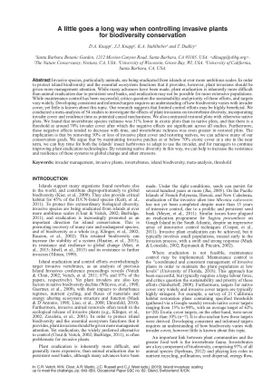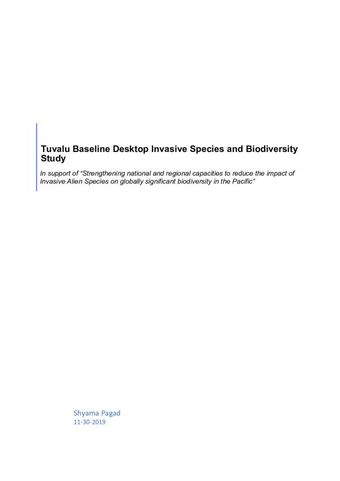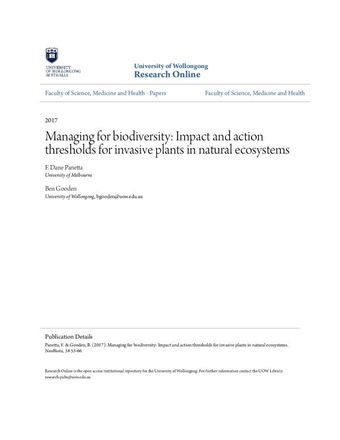A little goes a long way when controlling invasive plants for biodiversity conservation
- Description:
- Invasive species, particularly animals, are being eradicated from islands at ever more ambitious scales. In order to protect island biodiversity and the essential ecosystem functions that it provides, however, plant invasions should be given more management attention. While many advances have been made, plant eradication is inherently more difficult than animal eradication due to persistent seed banks, and eradication may not be possible for more extensive populations. While maintenance control has been successful, critics question the sustainability and priority of these efforts, and targets vary widely. Developing consistent and informed targets requires an understanding of how biodiversity varies with invader cover, yet little is known about this topic. Our research suggests that limited control efforts may be highly beneficial. We conducted a meta-analysis of 54 studies to investigate the effects of plant invasions on invertebrate diversity, incorporating invader cover and residence time as potential causal mechanisms. We also contrasted restored plots with otherwise native plots. We found that invertebrate species richness was 31% lower in exotic plots than in native plots, and that there is a threshold at around 70% invader cover after which the negative effects are significant across all studies. Furthermore, these negative effects tended to decrease with time, and invertebrate richness was even greater in restored plots. The implication is that by removing 30% or less of invasive plant cover and restoring natives, we can achieve many of our conservation goals. We argue that by maintaining invasive patches at or below 70% exotic cover at a site in the near term, we can buy time for both the islands insect herbivores to adapt to use the invader, and for managers to continue improving plant eradication technologies. By retaining native diversity in this way, we can help to increase the resistance and resilience of these systems to global change and other stressors.
- Display date:
- 2019
- Collections:
- Secretariat of the Pacific Regional Environment Programme (SPREP)
- Publisher:
- International Union for Nature Conservation (IUCN)
- Content partner:
- Secretariat of the Pacific Regional Environment Programme (SPREP)
- Availability:
- Not specified
-
Copyright status: All rights reservedFind out more about what you are able to do with this itemThis item is all rights reserved, with means you'll have to get permission from Secretariat of the Pacific Regional Environment Programme (SPREP) before using it. For more information, please see our use and reuse page.What can I do with this item?Non-infringing useNZ copyright law does not prevent every use of a copyright work, and this item may be hosted by an international institute or organisation. You should consider what you can and cannot do with a copyright work.No sharingYou may not copy and/or share this item with others without further permission. This includes posting it on your blog, using it in a presentation, or any other public use.No modifyingYou are not allowed to adapt or remix this item into any other works.No commercial useYou may not use this item commercially.
Related items
Welcome and warm Pasifik greetings
The information on this site has been gathered from our content partners.
The names, terms, and labels that we present on the site may contain images or voices of deceased persons and may also reflect the bias, norms, and perspective of the period of time in which they were created. We accept that these may not be appropriate today.
If you have any concerns or questions about an item, please contact us.



